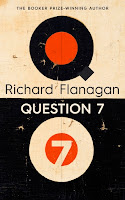“In the early spring of nineteen sixty-three, there was a rumour — unconfirmed and a little scandalous — that George Smiley might almost be happy.” (p. 26)
I was going to ask for this for Christmas and then couldn’t wait: a new le Carré novel despite the author no longer being in the field, and a new adventure for spymaster George Smiley, for all he long ago retired.
Whereas Silverview (2022) was written by le Carré and finished after his death by his son, the novelist Nick Harkaway, this is an entirely new novel by Harkaway. Or rather, it isn’t, because it’s been devised to fit neatly between two of the old classics, The Spy Who Came in from the Cold (1963) and Tinker, Tailor, Soldier, Spy (1974). As well as owlish George Smiley, it features lots of familiar characters from both those books — such as Control, Toby Esterhase, Peter Guillam, Bill Haydon, Alec Leamas, Connie Sachs and Ann Smiley — and makes subtle play with the fact we know what is to be befall some of them in events to come.
Of course, this isn’t a new phenomenon. People other than Arthur Conan-Doyle were writing Sherlock Holme stories while Doyle was still alive. Kingsley Amis wrote Colonel Sun (1968) four years after the death of James Bond creator Ian Fleming. New stories continue to be written about Bond and Holmes and whoever else, some continuing their adventures into the present day, other working as period pieces, looking back to the time when the original adventures were set. (See, to choose an example entirely at random, Sherlock Holmes and the Great War.)
That’s the big point of difference here: le Carré was grappling with the contemporary world, all gritty, cynical realism. Karla’s Choice is a historical novel, conjured as much from depictions of the previous books on TV and in film. It is a pastiche.
I think it’s a good one: it feels authentic and I suspect would work well if you (re)read the Smiley novels in order, inserting this one into place. The familiar characters are well captured, Harkaway acknowledging in his both author’s note and acknowledgements the debt he owes to the various actors who’ve realised the characters on screen. At the same time, new characters, whose fates we can’t be sure of, are also nicely delineated and feel in-keeping.
In the opening pages, Harkaway accepts that the very idea of a new Smiley novel not written by his dad will be unthinkable to some. He then invites us to see, with him, how well he’s achieved his aim. That’s clever: co-opting us, perhaps even seducing us despite ourselves. We become part of the game.
And that matches the plot. Susanna Gero, a Hungarian refugee with a new life in London working for a literary agent, answers the door of her office to a strange man — who has orders to kill her boss. Susanna’s quick-thinking and brave response leads to attention from the Circus, and soon she’s embroiled in the secret world. George Smiley should not be involved as he recently retired, following the events of The Spy Who Came in from the Cold. But he and Susanna find that once ensnared with the ‘grey mistress’ of the service, it is all-but impossible to escape…
As well as authentic, it’s an enjoyable, engaging story — and, in its last section, extremely tense. The period setting with Smiley in his prime works better, I think, than seeing the character living on agelessly into the modern age, almost but not quite giving his view on Brexit, as per le Carré’s A Legacy of Spies (2017).
But at the same time something is lost in making Smiley a figure from history. There’s no longer that tantalising sense of this all being real and now and incredibly relevant, of le Carré using a fictional spy story to raise the curtain a bit on what's really going on.
There’s one moment where we come close, an echo of today in this echo of the past. As the stakes get ever higher, Smiley considers what difference it will make to the wider world if he is successful in besting his opposite number, the Russia spymaster known as Karla.
“Would Moscow abruptly suffer a shortage of brutal and brutalised men, thinking to make good whatever sinkholes were in them by destroying the West? By finally achieving Peter the Great’s ambitions and standing Russia at the pinnacle of the world? Would the Cold War, with all its terrible arsenals and its power to compress and unshaped ordinary lives, come to an end? Would the nuclear demon go back to hell, and the fear of a Russian land invasion sweeping everything before it, not stopping until it reached Normandy and Lagos and Palermo, fade into history because Karla fell to Smiley’s unknightly lance?” (p. 220)
And then, in the end, there is the choice Karla makes that gives the book its title. It is not what Karla does but the thought of how Smiley will need to respond that is what resonates.
See also me on:
- Titanium Noir (2023) by Nick Harkaway
- Silverview (2021) by John le Carré and Nick Harkaway
- A Legacy of Spies (2017) by John le Carré
- The Mission Song (2006) by John le Carré
- The Constant Gardener (2005 film version of 2001 novel by John le Carré)
- The Secret Pilgrim (1990) by John le Carré
- Smiley’s People (1979) by John le Carré
- Tinker, Tailor, Soldier Spy (1974) by John le Carré
- The Honourable Schoolboy (1977) by John le Carré
- The Looking-Glass War (1965) by John le Carré






















